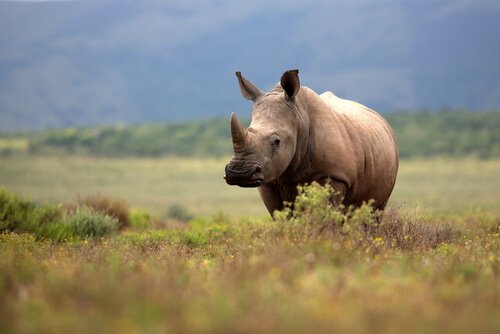Injecting Venom into Rhinoceros Horns to Protect Them


Written and verified by the vet Eugenio Fernández Suárez
Rhinoceros horns are some of the most sought after objects in the world. This has created a serious threat to these animals. For instance, animal traffickers hunt them just for their horns. In one African reserve, the authorities have decided to use a strategy that’s almost radical in an effort to protect their rhinoceroses from illegal poaching: injecting venom into the rhinoceros horns.
While this venom doesn’t affect the health of the animals, it could certainly affect humans if they consume products that contain the venom. Read on to learn more about this project.
Injecting venom into rhinoceros horns to protect them
This is taking place in the Sabi Game Preserve, a private reserve within the famous Kruger National Park, the most visited park in South Africa. The project consists of injecting dozens of rhinoceroses with a mix of indelible pink dye and some relatively common anti-parasitic treatments.
This venom eliminates ticks from cows and other animals, and is in common use. However, it can provoke nausea and vomiting in humans if they eat it.
Based on this premise, injecting venom into rhinoceros horns makes these unsafe for human consumption. People won’t be able to use the powder from these horns. The pink dye, however, isn’t as strong as some digitally edited images on the internet would appear to show.

The managers of the park assure the public that they aren’t doing anything illegal. They are even alerting people to the project within the park itself by means of notices and social networks. It’s still a normal anti-parasitic treatment for these rhinoceroses, although of course it’s not usually injected into the animals’ horns.
The dye can be detected by airport detection systems. This also makes it more difficult for the illegal traffickers to move injected horns out of the country.
Although having said that, some experts have called into question the effectiveness of the program. They say that the poachers will simply move to other areas to hunt. It also will be virtually impossible to carry out the process on a great number of animals, since injecting the rhinoceros requires anesthesia.
The value of rhinoceros horns
Rhinoceros horns are some of the most highly prized objects by poachers that carry on illegal hunting and trading of threatened species. While the use of these horns is occasionally ornamental, normally human consumption is the purpose for which the hunting takes place.
This practice has put all species of rhinoceros on the planet in grave danger of extinction. The populations of rhinoceroses in the wild are rapidly diminishing due to indiscriminate hunting.

This is due to the fact that the rhinoceros horn is a key ingredient in Asian medicine. Why? Because the powder of rhinoceros horn supposedly has magical curative properties. This is of course totally false. According to Chinese tradition, it can cure a range of diseases from cancer to infertility, besides infectious diseases and parasites.
The uselessness of the rhinoceros’ horn in medicine is common knowledge. Why can’t horns be an effective medical treatment? It’s because the only substance these horns contain is keratin. This is the same substance that makes up all animals’ hair or fingernails, including humans.
So eating rhinoceros horn powder has the same pharmaceutical effect as for example eating fingernails: absolutely none.
Due to the above issues, the rhinoceros is becoming in danger of extinction thanks to oriental medicine, although some initiatives like this are helping to protect this emblematic species from extinction. What do you think? Will this project of injecting venom into rhinoceros horns help to save them?
This text is provided for informational purposes only and does not replace consultation with a professional. If in doubt, consult your specialist.